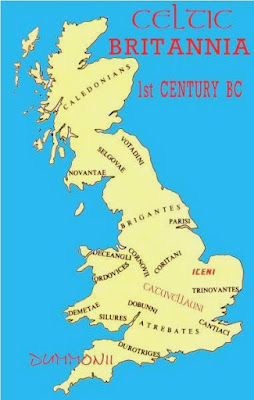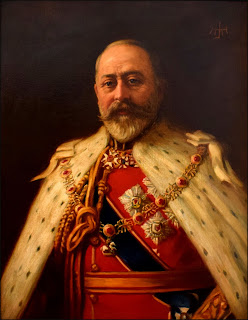Iron Age and Celts
Geography
All Celtic languages
extant today belong to the Insular Celtic languages, derived from the Celtic
languages spoken in Iron Age Britain and Ireland. They were separated into a Goidelic
and a Brythonic branch from an early period.
Linguists have been arguing for many years
whether a Celtic language came to Britain and Ireland and then split or whether
there were two separate "invasions". The older view of prehistorians
was that the Celtic influence in the British Isles was the result of successive
invasions from the European continent by diverse Celtic-speaking peoples over
the course of several centuries, accounting for the P-Celtic vs. Q-Celtic
isogloss. This view has been challenged by the hypothesis that the Celtic
languages of the British Isles form a phylogenetic Insular Celtic dialect
group.
In the 19th and 20th centuries, scholars commonly dated the
"arrival" of Celtic culture in Britain (via an invasion model) to the
6th century BC, corresponding to archaeological evidence of Hallstatt influence
and the appearance of chariot burials in what is now England. Some Iron Age
migration does seem to have occurred but the nature of the interactions with
the indigenous populations of the isles is unknown. In the late Iron Age.
According to this model, by about the 6th century (Sub-Roman Britain), most of
the inhabitants of the Isles were speaking Celtic languages of either the Goidelic
or the Brythonic branch. Since the late 20th century, a new model has
emerged which places the emergence of
Celtic culture in Britain much earlier, in the Bronze Age, and credits its
spread not to invasion, but due to a gradual emergence in situ out of Proto-Indo-European culture.
Classical writers did not apply the terms Κελτοί or
"Celtae" to the inhabitants of Britain or Ireland, leading a number
of scholars to question the use of the term Celt to describe the Iron Age
inhabitants of those islands. The first historical account of the islands of
Britain and Ireland was by Pytheas, a Greek from the city of Massalia, who
around 310-306 BC, sailed around what he called the "Pretannikai
nesoi", which can be translated as the "Pretannic Isles".[86] In general, classical writers referred
to the inhabitants of Britain as Pretannoi or Britanni. Strabo, writing in the
Roman era, clearly distinguished between the Celts and Britons.
Agriculture in Iron Age
 In
agriculture, new improvements are observed, such as the irrigation of fields
through wells and ditches, the fertilization of fields with manure, etc. During
the Bronze Age and the Iron Age, two new metals (iron and bronze) are incorporated
with which they began to build new tools.
In
agriculture, new improvements are observed, such as the irrigation of fields
through wells and ditches, the fertilization of fields with manure, etc. During
the Bronze Age and the Iron Age, two new metals (iron and bronze) are incorporated
with which they began to build new tools.
But not
only the iron tools helped the farmers, they used horses and bulls to pull the
plough, so the agriculture became even more manageable.
Before this
improvement, agriculture, most humans spent most of the day looking for food. But
now, only some people had to work to feed, and some people would do other
activities. For example, other people could specialize in the manufacture of
footwear or weapons.
CELTIC AGRICULTURE
Agriculture
was the main activity of the Celtic community. Although their practice varied
with the land type, the Celts generally used a mixed agriculture, with cattle
and crops.
 The
countryside was covered with small farms and villages, with fortified
settlements on the summits that served as markets, craft centers and tribal
capitals.
The
countryside was covered with small farms and villages, with fortified
settlements on the summits that served as markets, craft centers and tribal
capitals.
The
Celtic’s most grew crop was cereal, but they cultivated beans and peas too. Bitter
Vetch, Fat Hen, Gold of Pleasure and other plants were cultivated as well. From
these plants and from fruits and berries, Celtic people had access to reliable
sources of protein, carbohydrates and vitamins.
Iron Age Houses
Those were constructed with organic elements that could be
found in the area.
The walls of roundhouses were dry stone filled with
clay and straw. Some poles attached to the floor were used to maintain the wall
as to hold the roof.
Wattle and daub is one of the oldest building technique. It was very
often to use the technique of interweaving long sticks in the poles. Hazel used
to grow near the forts and it was a kind of wood they were able to collect
easily.
Daubing is the method used to weather proof the wattle with a mixture of
clay, sand, straw and manure.
In the inside of the roundhouse there was space enough
for at least 10 people and the animals that were putted inside the house at
night and in the middle of the house there was a fire that was used to warm up
the house and also for cooking. Just on top on this fire, a hole was left when
the roof was constructed, for letting part of the smoke to got out. In spite of
this, it is thought that a lot smoke used to be inside the room.
 Roundhouses were not always built of clay and mud. In
some places around UK, rests of old this houses have been found, and it seems like
they were built of stone stacked and attached with some kind of material, like
clay.
Roundhouses were not always built of clay and mud. In
some places around UK, rests of old this houses have been found, and it seems like
they were built of stone stacked and attached with some kind of material, like
clay.
In some occasions, many roundhouses were built near
each other, forming a fort, which used to have a wall/ditch Celts used to built
a few meters away of the houses for protecting themselves.
Other interesting facts
The Iron Age Celts
were a tribe of people who lived all over Europe about two thousand years ago.
At one time, you could find tribes of Celts in modern day Spain, France, northern
Italy, and as far east as Russia.
Around 500 BC, the ancient Celts migrated and settled in modern day
Ireland, Wales, Scotland, and the Isle of Man.
- They lived in small
farming communities.
- They never built
cities.
- They were fierce
warriors. But they never founded an empire.
- The Celts were a
proud and honorable people.
- They were also very
clean. The Celts are credited with the invention of soap!
- They loved music.
They loved to boast.
- And they loved to
make up stories, especially stories about the little people - fairies,
elves, and leprechauns.
- Their culture lives
on today in music, dance, story, and song.
Marriage:
When a woman married, she joined her husband's
clan. You were always a member of your own clan. You never escaped that
obligation and membership. But your husband's clan took precedence.
Clothing:
The ancient Celts loved color. They used huge
looms to weave richly dyed wool in colorful plaids. They made tunics to wear
from some of their fabrics.
Both men and
women wore tunics. A man's tunic stopped at the knees. A woman's was floor
length. They were both loosely gathered at the waist with a belt.
Both men and
women wore shawls over their tunics, wrapped loosely around their shoulders.
They wore leather sandals.
Jewelry:
The Celts
loved jewelry. Gold was hard to get. Silver was even harder to find. Jewelry
made of gold or silver was highly coveted. But they made jewelry from many
things, including horn, feathers, stones, bronze and beads. Both men and women
were fond of wide necklaces worn like a collar around the neck. They decked
themselves out with arm bands, bracelets, ankle bracelets, rings (lots of
rings), and ornate belts. They fastened their cloaks with jewelry brooches and
ornate pins. They loved glitter and color.




Comentarios
Publicar un comentario